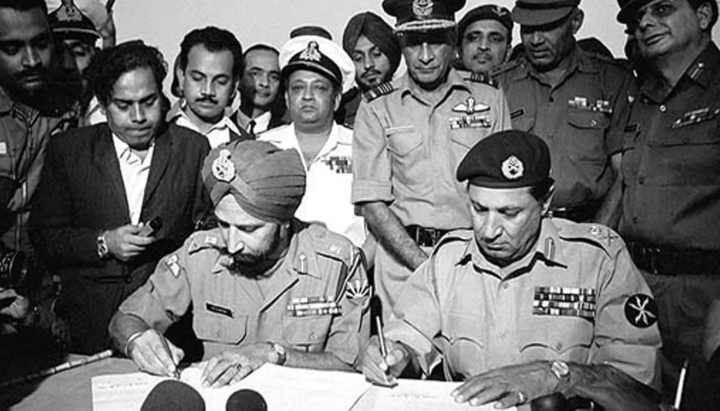Pakistani troops surrendered to allied Indian and Bangladesh forces on December 16, 1971 evening after a brief negotiation, the prelude of which has been sketched by a former Indian military captain describing first moments of victor's interactions with the defeated army.
The then young captain Nirbhay Sharma, who subsequently became a lieutenant general, said he was in the first group of Indian soldiers to step into Dhaka city as part of advanced allied troops.
Decades after the episode he came up with a signed memoir, describing a little known story of events of the first hours of the day, acknowledging that Bangladesh's freedom fighter Abdul Kader Siddique also accompanied the advanced allied troops.
Sharma, who later served as India's governor of Arunachal Pradesh and Mizoram, said they had entered "Dacca" through the Mirpur Bridge to make their way to Pakistan's military headquarters.
But some events upset their first attempt to reach Pakistani commander Lieutenant General AAK Niazi, to whom they, however, reached subsequently carrying a message from Major General Gandharv Nagra, India's general officer commanding for 1010 area.
Sharma said on their second journey, this time along with his commanding officer of India's 2 Para Battalion Colonel Pannu and few others, they succeeded in reaching the message, again as the "first troops" to enter the enemy held Dhaka Cantonment.
"While the battalion made a triumphant entry, Colonel Pannu, with me and a few other officers, made a dash to General Niazi at his headquarters," read Sharma's article, appeared in India's The Print newspaper.
"As we entered Pakistan's Eastern Command Headquarters and parked our jeeps next to General Niazi's office, a smartly attired, tall and well-built soldier confronted us," he wrote.
Sharma added that the "stick orderly standing guard" blocked the Indians entry into the office as he was quite unaware of the goings-on and did not know "what to do or say".
"He asked us not to park our jeeps in the space reserved exclusively for his general. We pushed him aside and barged into the general's room," Sharma wrote.
He recalled that Colonel Pannu "looked hard at Niazi and the latter could not meet his gaze" while the "unshaven" top Pakistani general held his head in both hands with despair.
"I clearly remember his mumblings - "Pindi mein baithe haramzaadon ne marva diya (Those sitting in Rawalpindi have let us down)".
He said that Rawalpindi kept fooling him until that morning that "help was on the way".
Sharma, the adjutant of the Indian battalion at Dhaka's doorstep, recalled that their troops took the enemy by surprise knocking at the doors of Dhaka at Mirpur Bridge point on the midnight of 15-16 December while shelling and desultory firing continued till December 16 morning.
He said Nagra earlier landed at the scene in the morning and "informed us that the Pakistani Army had agreed to surrender and we were to take a message for Lt General AAK Niazi".
The message read: “My dear Abdullah, I am here. The game is up, I suggest you give yourself up to me and I will take care of you.”
According to Sharma, Nagra's aide de camp Captain Hitesh Mehta was asked to accompany him while Pakistani troops were on position on other side of the bridge.
Initially the two captains got into a jeep with Nagra's handwritten message for Niazi, who was acquainted to the Indian general since their early age and "were on first-name basis".
Sharma said as they moved to the jeep, two other officers, Major JS Sethi and Lieutenant Tejinder Singh jumped into the vehicle.
"Oblivious to the impending danger, all of us were excited at the thought of moving into Dhaka with the message of surrender and making history," Sharma wrote.
But, he recalled, little did they, young officers, knew at the time that the Pakistan army on the other side had not received instructions to surrender and so "they opened fire as we crossed the bridge. We stopped".
"Collecting all my wits, I shouted to tell them to stop firing. The firing stopped" but immediately the enemy soldiers surrounded and disarmed the small Indian detachment, he wrote.
The Indian officers then asked a Pakistani junior commissioned officer (JCO) to call a senior officer while Sharma simultaneously threatened him with dire consequences if they tried harming them saying, the Indian army surrounded Dhaka and their general had agreed to surrender.
According to Sharma, fortunately soon a Pakistani captain arrived and took the detachment to the Mirpur Garrison where its commander asked them to wait and nearly an hour later Major General Mohammad Jamshed, GOC of Dhaka Garrison arrived there.
Along with Jamshed they returned to Mirpur Bridge in their Indian army jeep while a Pakistani one followed them and on their way back "we were fired upon again, neither side knowing who we were".
He said Major Sethi received a medium machine gun burst on his left leg and another bullet pierced the helmet of Singh right in the middle, though was fortunately deflected but "the situation was restored and we reached our side of the bridge".
Talking to BSS Kader Siddique recalled that a white shirt was hoisted atop the Indian army jeep that carried the junior Indian officers as no white flag was available instantly and on their way back to the Mirpur Bridge somehow was dropped somewhere leaving them unprotected that draw the enemy fires.
Sharma wrote, shortly thereafter, at 10:42 am, being accompanied by Pakistani officers, the Indian officers' detachment reentered Dhaka to hand over Niazi the Nagra's chit.
Pakistani military spokesman Major Siddiq Salik in his "Witness to Surrender" said receiving Nagra's message Niazi briefly discussed the situation with senior generals present, including navy's top commander in East Pakistan Rear Admiral Mohamad Shariff and Major General Rao Farman Ali.
They both, he said, suggested Niazi to give up and respond to Nagra's call as Pakistani side did not have enough strength to defend "Dacca".
"General Niazi sent Major General Jamshed to receive Nagra," Salik wrote.
Kader Siddique's account
Talking to BSS, Siddique said Jamshed came to the scene in a Mercedes car followed by several Pakistani military vehicles and Nagra and two other Indian brigadiers, San Singh and Klair and he himself got on board the car's backseat.
He said Jamshed sat on the front seat beside the driver on their way to Dhaka Cantonment and halted briefly at Jamshed's makeshift office at Dhaka Residential School, from where they tried to make a phone to Niazi but found the line to be dead.
The delegation then went straight to Dhaka Cantonment and was received by a Pakistani captain at Niazi's office who told them the general would come there shortly.
"After 4 or 5 minutes Niazi came and the two sides saluted each other and shook hands . . . I could not extend my hand to shake his (Niazi's) hand," Siddique said.
The 1971 war documents suggest nearly an hour later the formal surrender negotiations took place after Indian Eastern Front's general staff chief Major General JFR Jacob arrived at Niazi's headquarters.
: BSS








